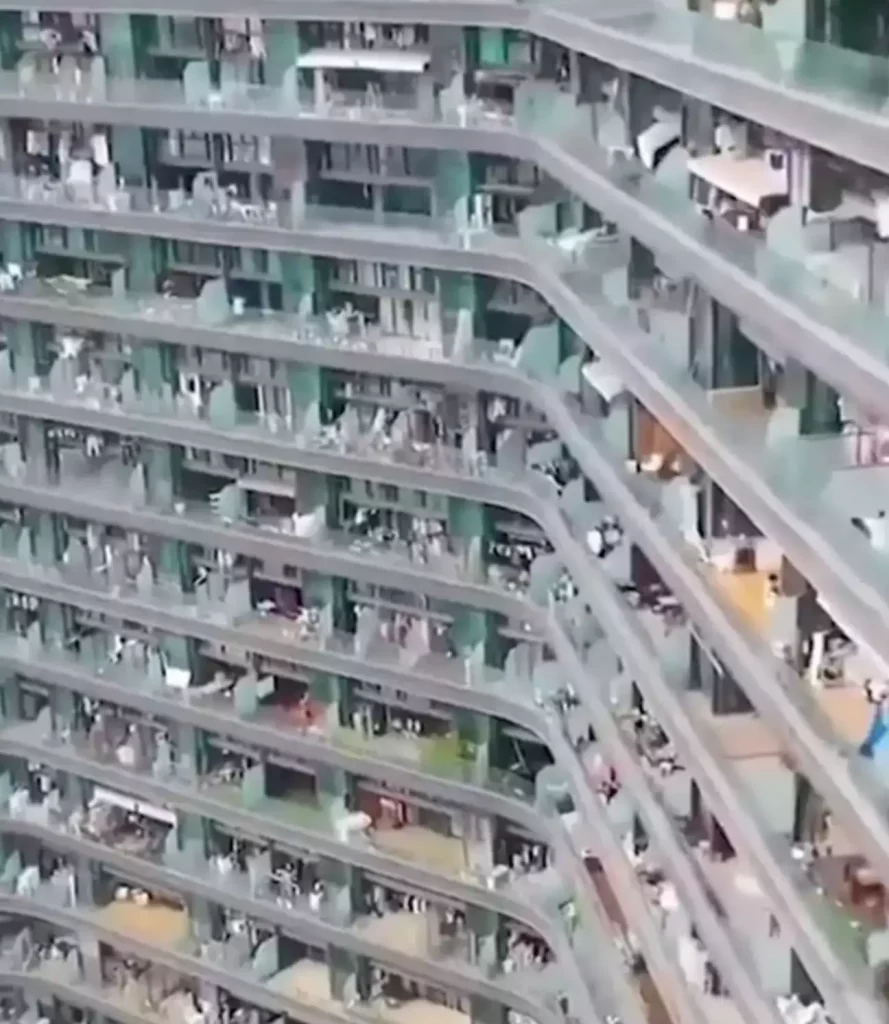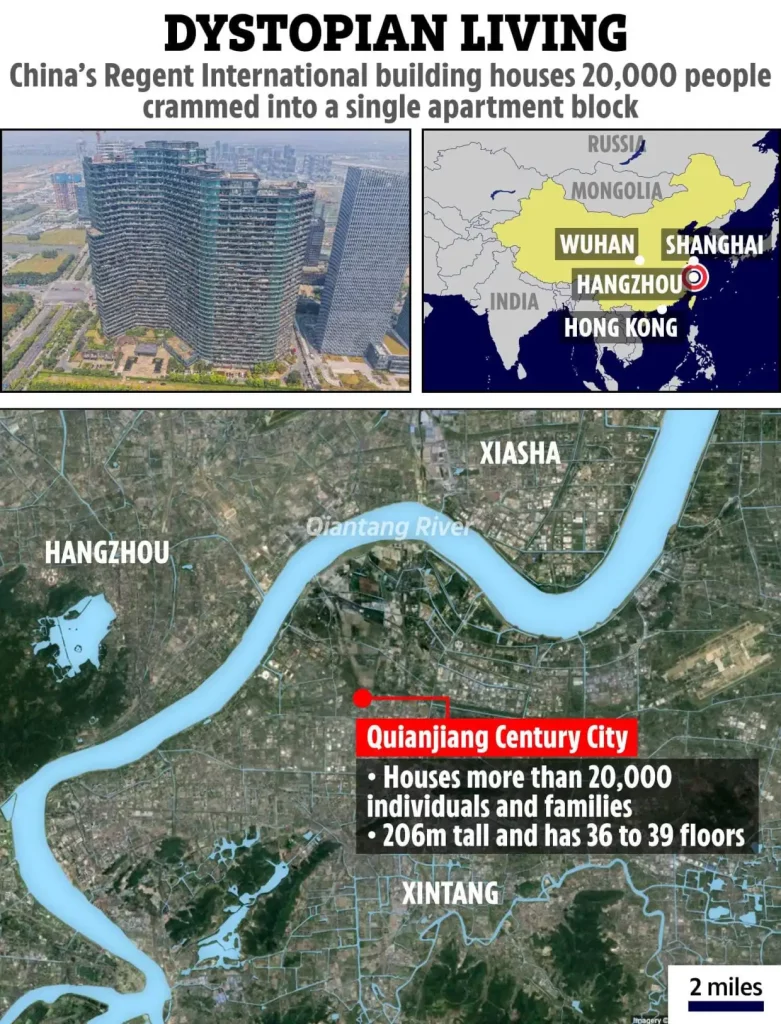Imagine a building that houses over 20,000 residents under one roof, with amenities ranging from grocery stores to nail salons. It sounds like something out of a sci-fi novel, but this massive structure is very real—and it’s in Hangzhou, China. Dubbed the “Dystopian Apartment,” this residential complex has captured global attention and sparked a mix of intrigue and unease. How did this building come to be, and what’s it like to live in such an enormous, self-contained environment? Let’s dive into the details.

Photo Credit: @fatheristheone | TikTok
The Enormous ‘Dystopian Apartment’ in Hangzhou
The so-called “Dystopian Apartment” is officially known as Regent International. Located in Qianjiang Century City, in Hangzhou’s central business district, this colossal building can host up to 30,000 residents. Designed by Alicia Loo, the chief designer of the 7-star Singapore Sands Hotel, the building opened in 2013 and currently accommodates around 20,000 people.
The building stands at an impressive 675 feet tall and features a distinctive S-shape, with 36 to 39 floors depending on the side. It’s one of the most densely populated structures in the world, serving as both home and workplace for many residents.
Inside the ‘Dystopian’ Block: A World Under One Roof
1. A City Within a Building
The building’s sheer size allows it to function like a small city. With over 30 floors filled with everything residents might need, it offers a level of convenience that’s hard to beat. From grocery stores and restaurants to swimming pools and internet cafes, Regent International is designed to keep its occupants within its walls. Even nail salons and fitness centers are part of the package, making it possible for residents to go days—or even weeks—without stepping outside.
2. Essential Amenities for Residents
The amenities in Regent International cater to the needs of a wide range of residents, from young professionals and students to influencers and freelancers. This wide variety of facilities allows residents to live a self-sufficient lifestyle, often without the need to commute. The complex’s restaurants serve a diverse selection of cuisine, while the grocery stores ensure that residents have easy access to fresh produce.
3. Affordable Living in the Heart of the City
One of the major attractions of Regent International is its affordability. Rent ranges from 1,500 RMB (around $200) to 4,000 RMB (just under $600) per month, depending on unit size. Given the cost-effectiveness of living in a prime area with all amenities at hand, it’s no wonder that many young professionals and college students have flocked to this building.
Is It Really ‘Dystopian’? The Pros and Cons
While many view Regent International as a futuristic model of sustainable living, others describe it as “dystopian.” The term, often associated with oppressive or dehumanizing societies, stems from concerns about privacy, space, and mental well-being.
1. The Pros: Convenience and Sustainability
Living in Regent International offers clear advantages. The most obvious benefit is convenience. Residents have access to a variety of services and facilities just steps away from their apartments. The building’s design also maximizes land use, making it an innovative solution for densely populated cities.

Photo Credit: Nevsedoma | The Sun
Another major benefit is sustainability. By consolidating thousands of people into a single building, the environmental impact is minimized—reducing the need for transportation and infrastructure spread across the city. Some even hail it as “the most sustainable living building on earth,” as it uses less land and centralizes resources.
2. The Cons: Limited Space and Privacy
Despite its perks, Regent International has its drawbacks. The lack of privacy is a major concern, as residents live in close quarters with thousands of others. With such a large population packed into one structure, the sense of personal space is significantly reduced. Many units are small, offering only the basics, which may not suit individuals who crave more room.
The confined nature of the building also raises questions about mental health. Being inside the same space for extended periods, with limited access to fresh air or nature, can be challenging. While some units offer balconies, not all residents have this luxury. The overall lack of outdoor spaces could affect physical and mental well-being in the long run.
A Look Beyond China: Similar Concepts Around the World
The idea of housing thousands of residents in a single complex isn’t unique to China. Other countries have experimented with similar approaches, albeit on a smaller scale.
1. Whittier, Alaska: A Miniature Version
In Whittier, Alaska, the entire population of 272 people lives in a single 14-floor building called Begich Towers. Much like Regent International, this building offers everything from a school and church to a post office and police station. While it’s not as massive as the “dystopian apartment” in Hangzhou, it provides a glimpse into how densely populated living can work in a different context.
2. Potential for Urban Planning Solutions
Given the ongoing housing crisis in many parts of the world, some urban planners see buildings like Regent International as potential solutions. By housing more people in a smaller footprint, cities could save land and reduce environmental impact. However, replicating this model in Western countries, where personal space and privacy are highly valued, could be a challenge.

Photo Credit: Nevsedoma
What Residents Say About Living in Regent International
Not surprisingly, opinions about life inside Regent International are divided.
1. Positive Feedback from Residents
For many residents, the building’s conveniences outweigh the downsides. The all-in-one lifestyle allows them to save time, avoid commuting, and access everything they need just a few floors away. Young professionals, in particular, appreciate the affordability and central location, which makes city life more accessible.
2. Criticism and Concerns
On the flip side, some residents express frustration with the lack of outdoor spaces and the constant proximity to thousands of neighbors. While the building isn’t a forced environment—people choose to live there—it’s easy to see how the term “dystopian” could be used. The thought of thousands of people living in one giant, self-contained building can evoke a sense of dehumanization, especially when considering mental health implications.
Is the Future of Urban Living Dystopian or Innovative?
The “dystopian apartment” in Hangzhou is both a marvel of modern architecture and a controversial approach to urban living. While it offers undeniable advantages in terms of convenience, affordability, and sustainability, it also raises questions about privacy, mental health, and the quality of life. As cities continue to grow and space becomes even more limited, buildings like Regent International could represent a glimpse into the future of urban living.
Conclusion: Would You Live in a ‘Dystopian’ Apartment Block?
The concept of living in a single building with thousands of others is not for everyone. While some may view it as an innovative solution to housing challenges, others see it as a step toward a more confined, impersonal society. Whether you find it fascinating or unsettling, there’s no denying that Regent International offers a unique perspective on how we might adapt to an increasingly crowded world.


